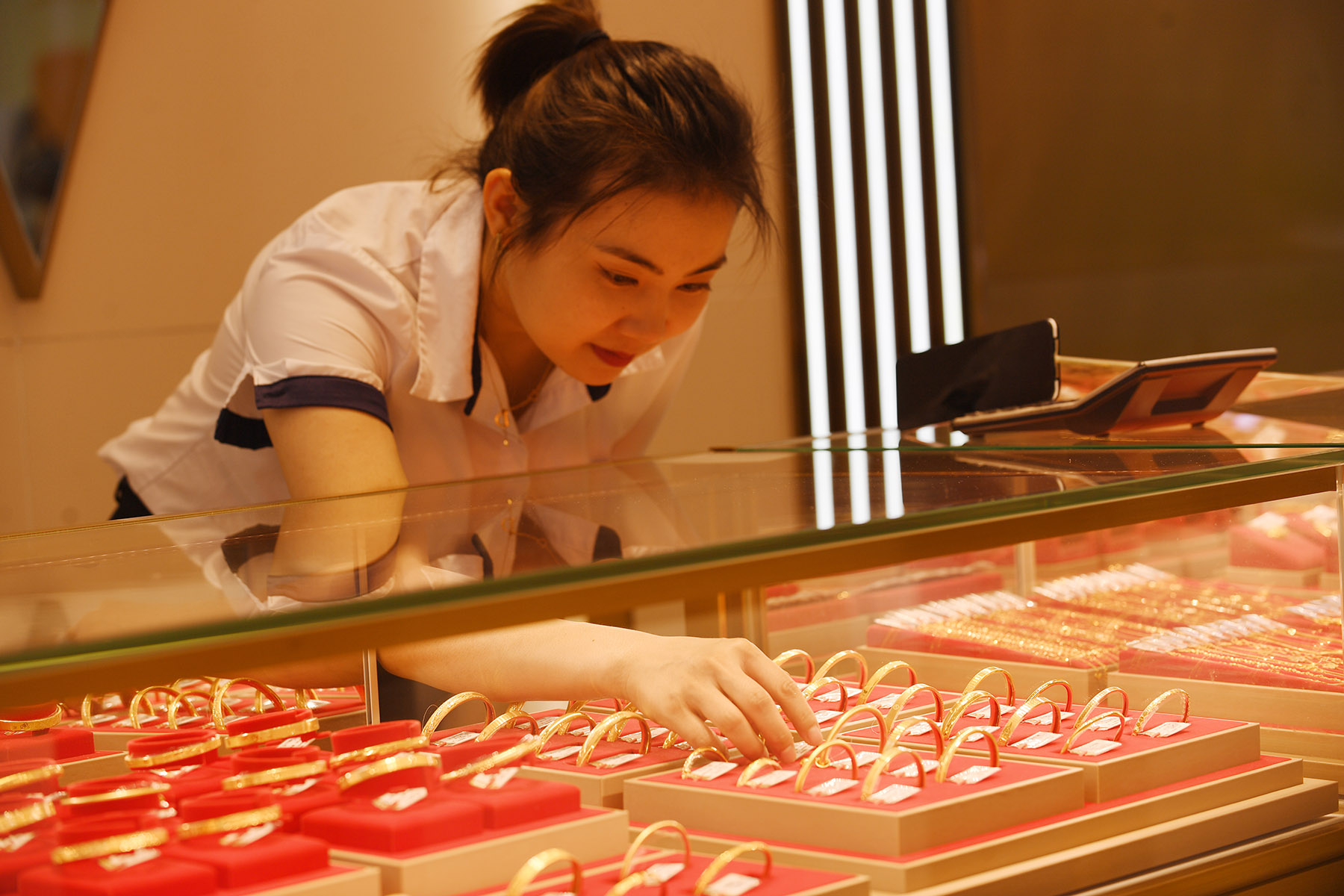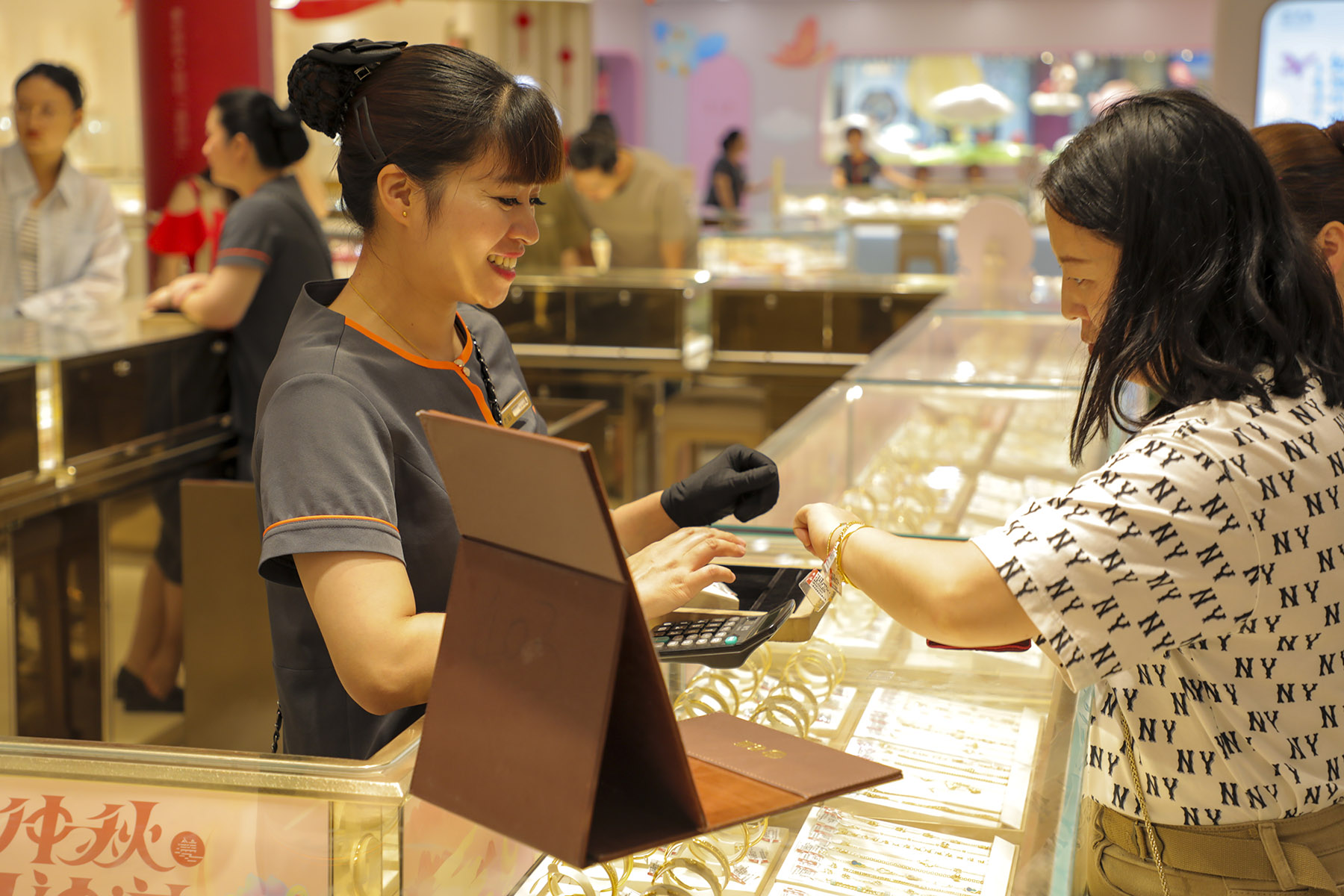Spot gold recently surged to historic highs on strong demand, Fed cuts

Gold prices have consistently reached all-time highs this year, yet this hasn't dampened consumers' eagerness for the precious metal.
What sets this year apart is the stark contrast in demand between gold jewelry and coins/bars since the year began, as consumers are gravitating toward investment-oriented products with little processing charges.
Meanwhile, many consumers opted to liquidate their holdings, leading to a thriving market in gold recycling and trade-ins, said industry observers.
Influenced by factors like geopolitical tensions, US Federal Reserve rate cuts, and global central banks' increase of gold reserves, they also forecast that gold prices may continue to rise. Against this backdrop, they indicated that the divergence between Chinese gold jewelry and gold coins/bars consumption may persist in the latter half of the year.
READ MORE: China's role in gold market to grow: WGC
This trend will continue to benefit upstream gold mining firms while creating challenges for downstream retail sales, they said, adding that companies need to innovate products with smaller weight increments and new features to attract consumers.
Elevated prices
Data from the World Gold Council reveals a 12 percent increase in gold prices in the first half of this year, with prices predominantly exceeding $2,300 per ounce in the second quarter.
The upward trajectory continued into the third quarter. On Sept 25, spot gold prices surged to a historic high of $2,670 per ounce, and may continue to keep hitting record highs, while gold prices denominated in Chinese renminbi on the Shanghai Gold Exchange also witnessed an uptick. On Sept 25, Shanghai Gold Au 99.99 contracts closed at 595.66 yuan ($85) per gram, with the peak price hitting 599.28 yuan per gram.
Accordingly, gold retail prices in China have also seen a rapid increase this year, with various gold jewelry brands like Chow Tai Fook and Chow Sang Sang pricing their products above 750 yuan per gram in September. Other brands like Chow Tai Seng, Lao Feng Xiang, and China Gold, set their gold jewelry prices mostly ranging between 730 yuan and 770 yuan per gram.
Wang Lixin, regional CEO of the World Gold Council (China), noted, "Last year, the primary drivers of rising gold prices were robust investment demand and heightened geopolitical risks. These factors continue to play an important role in driving up gold prices this year. Additionally, the inflow of Western gold exchange-traded funds and the initiation of the Federal Reserve rate cut cycle have contributed to declining interest rates and a weaker dollar, further propelling gold performance."
Liu Yuxuan, a precious metals researcher at Guotai Junan Futures, said, "Investor enthusiasm for gold investment remains robust, with recent price surges accompanied by investors' sustained long positions. Many investors view gold as a hedge against risks associated with other assets and as a secure long-term investment option. This trend reflects a pessimistic outlook on the global economic situation, where investors seek stability in an uncertain economic environment."
"The current scenario suggests that despite Fed's 50 basis points rate cut this year, there is potential for another 50 basis points cut in November or December, and anticipated cuts of 100 basis points in 2025 and 50 basis points in 2026, totaling a potential 250 basis points cut. While gold prices have already surpassed $2,600 per ounce as some markets may have factored in the 100 basis points rate cut for the year, the expectation of a 250 basis points cut is likely not fully priced in. This provides strong momentum for gold prices to continue their ascent at elevated levels," Liu said.
Furthermore, a recent report from the World Gold Council highlighted that central banks' gold purchases have and will continue to contribute to the uptrend in gold prices. In July, global central banks' net purchase of gold reached 37 tons, marking a 206 percent increase from the previous month, the highest monthly increase since January. The WGC has forecast a continuation of this trend among global central banks in the near future.

Choices impacted
Against the backdrop of soaring gold prices, a divergent trend has emerged in the demand for gold jewelry, coins and bars since the year began.
Investment in gold bars and coins surged to 80 tons in the last quarter, marking a 62 percent increase year-on-year and the strongest second-quarter performance since 2013. The rise in gold prices and investor interest in safe-haven assets propelled total investment in gold bars and coins to 190 tons in the first half, a significant 65 percent surge from the previous year's first half, according to the WGC.
Conversely, demand for gold jewelry in China hit a second-quarter low not seen since 2009, at 86 tons. First-half jewelry consumption in China dropped by 18 percent year-on-year to 270 tons.
Wang of the WGC said, "The motivation for investors to purchase gold bars and coins is relatively straightforward, primarily for investment purposes as gold has outperformed other forms of investment in general, delivering impressive returns at over 22 percent in Jan-Sept period, which is undeniably eye-catching. Moreover, there was an unprecedented surge in saving intentions among Chinese. Compared to the fluctuating Chinese renminbi, gold's role as a store of value is favored by savers."
"While gold jewelry does offer a store of value function, consumers primarily purchase it for personal use, weddings, or gifting, with value preservation being an 'added' value. With continually rising gold prices and a slowdown in disposable income growth, gold jewelry is displaying characteristics of a typical consumer product, where consumers are more price-sensitive, resulting in a decline in gold jewelry consumption. However, it's worth noting that despite the overall decline, gold jewelry, compared to other jewelry types (platinum, diamonds, etc.), remains significantly ahead, with gold continuing to be the primary revenue generator for jewelry retailers," he said.
Wang predicted that the divergent purchase trend for gold jewelry, gold coins and bars in China observed in the first half may persist throughout the year.
"Gold jewelry may witness a slight uptick in the upcoming peak season, which is October as gold demand for wedding use may grow, but its overall performance may still be relatively subdued compared to previous years, primarily due to high prices and expectations of slowing economic growth. While investment demand may have been impacted by volatile gold prices, the environment for gold investment — lackluster performance of other assets, ongoing decline in interest rates (domestic and foreign), and economic growth uncertainties — is likely to bolster gold investment demand," he added.
Divergent fortunes
With gold prices remaining at elevated levels, companies across the gold industry chain are encountering varying fortunes, with upstream mining firms enjoying sustained profit growth while downstream gold jewelry retailers confront escalating operational challenges.
A study by media outlet Caijing revealed that as of Aug 23, out of the 12 A-share listed gold mining companies, 10 companies had reported their first-half performance results, with a collective net profit of around 19 billion yuan, a 48 percent increase from the same period last year. Several companies achieved their best performances since going public.
Zijin Mining, one of China's leading mining companies, reported an increase in first-half net profit of 46.42 percent year-on-year to 15 billion yuan. The company attributed this performance boost to higher production volumes of gold, copper, and silver, along with increased sales prices compared to the previous year. During the period, the company's gold production volume reached around 35.4 tons, a 9.5 percent increase year-on-year, surpassing the growth rates of copper production volumes.
In contrast, several gold jewelry retail companies experienced a decline in performance in the first half. For instance, Chow Tai Seng's net profit decreased by 18.71 percent year-on-year to 601 million yuan. In the first half, Chow Tai Fook reduced its mainland store count by 180.
Many retailers are employing promotional strategies such as 20-60 yuan gold price reduction by grams and free trade-ins to entice customers.
ALSO READ: China's appetite for gold investment up in Q2
Song Yu, a salesperson at a gold store in Chaoyang district of Beijing, said many customers inquired about gold during their visits but hesitated to make purchases due to the high gold prices. "Consumers are concerned about buying at high prices, fearing potential losses if gold prices drop."
"While the surge in gold prices may encourage some consumers to buy gold for preservation purposes, such consumers typically favor products like gold bars. Jewelry items, due to brand premiums, craftsmanship costs, depreciation, and other added values, are not as cost-effective as bars and coins for value preservation," he explained.
To sustain profits for retailers, Wang of the WGC suggested that while introducing products with high profit margins, such as intricate designs and various inlays to cater to buyers with greater purchasing power, jewelry makers and sellers need to ramp up efforts in developing cost-effective pieces as well as lower-cost items such as Hard Pure Gold.
Hard Pure Gold is a new form of 999 gold (24K) with extra hardness and durability. It involves adding a certain amount of rare elements, commonly known as hard gold powder, enabling enhanced craftsmanship with the most lightweight items.
Wang suggested innovating existing business models and development strategies, transitioning from scale-based expansion to high-quality development that caters to segmented markets and diverse demands among consumers.


